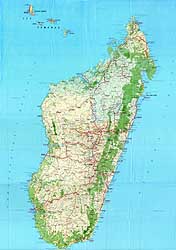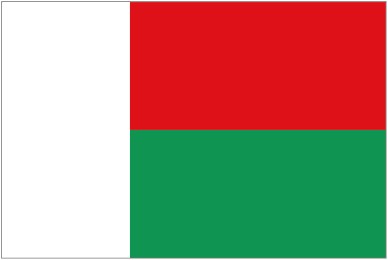-
-
- Madagascar Map
|
-
-
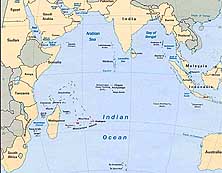
-
- Map of the Indian Ocean
|
|
-
|
- latest picture: November 9, 2011
|
|
-
-
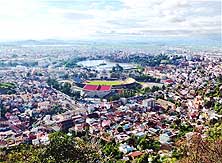
|
-
-
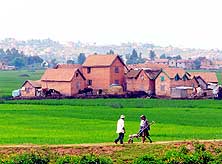
|
-
-
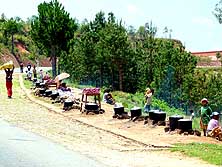
|
- 223
Antananarivo, the capital of Mada-
- gascar, has many fascinating corners
- despite its chaotic hustle and bustle
|
- 224
Already on the outskirts of the
- crowded capital Antananarivo rice fields
- are spreading out – after the hectic and
- chaotic city life a pleasant sight
|
- 225
Street kitchen line the way. Sweet
- potatoes are one of the vegetables being
- cooked on charcoal in the big pots
|
-
- After Emil feels better, we are heading straight to the “Lemur’s Park”,
situated picturesquely at the Sisaony River, 15 miles West of Antananarivo. With
anticipated joy we are looking forward to another encounter with these cute fellows of
which we have grown so fond of. Already when the gate opens at 9am, we are there, pay Aria
30’000 (US$ 14) for the two of us, including a guide, and join the first tour
consisting of a Belgian and French guy with their English speaking guide. The first thing
we experience is a fierce fight between two skink lizards. We watch how one is finally
swallowing piece by piece of the still twitching tail it has just bitten off his enemy.
“The victim will survive and its tail will regrow”, our guide appeases us.
|
-
-
-
-
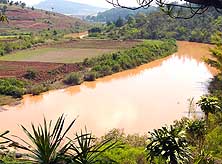
|
-
-
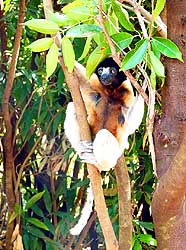
|
-
-
-
-
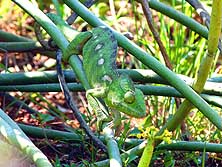
|
- 226
After heavy rains and due to erosions,
- the Sisaony river at the lemur park, 15 miles
- West of the capital Antananarivo along the
- RN1, got its reddish brown color of the soil
|
- 227
The crowned Sifaka
- (Propithecus coronatus) is
- peeking curiously through
- the tree leaves
|
- 228
The Malagasy Giant Chameleon
- (Furcifer oustaleti) with a length of
- up to 27 inches is considered as the
- biggest species of chameleon
|
-
- Slowly our cute darlings appear one after the other, swinging from tree to tree: The
Coguerel’s Sifaka, the Crowned Sifaka, the Common Brown Lemur, the Black and White
Ruffed Lemur, the Lesser Bamboo Lemur, the Black Lemur and the Ring-tailed Lemur.
“Who eyes whom?” we often ask when they are observing us jauntily from their
vantage point.
|
-
-
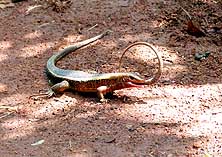
|
-
-
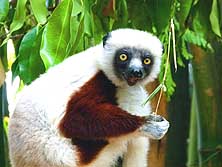
|
-
-
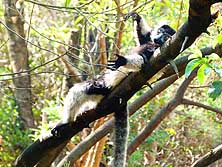
|
- 229
We hear a fight and see this Skink
- lizard (Zonosaurus laticaudatus)
- swallowing the tail of its enemy. Our
- guide says that the victim will survive
- and its tail will regrow
|
- 230
“Am I not a cute fellow?” The
- Coquerel’s Sifaka (Propithecus coquereli)
- has a beautiful dense fur. It lives mostly
- in a group with four or five others
|
- 231
“Am I not enviable?” The
- Black-and-White Ruffed Lemur
- (Varecia variegata) is endemic to the
- island of Madagascar and belongs to
- the threatened species. It is spending
- most of its time in the high canopy
|
-
- It is 10am, feeding time. This reserve is too small to be able to sustain the entire
population with leaves. Therefore, they get some additional food – vegetables and
fruits, the bananas being their favorite. Each animal has its own green feeding bowl thus
avoiding any fights. We watch them nibbling for a while and then we continue to the two
night active lemurs that are living in cages and fed with insects: The Greater Dwarf Lemur
and the Gray Mouse Lemur, which indeed is not bigger than a mouse.
|
-
-
-
-
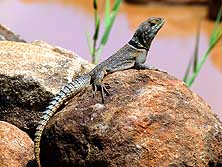
|
-
-
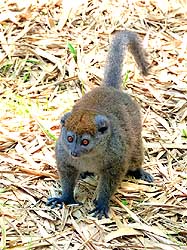
|
-
-
-
-
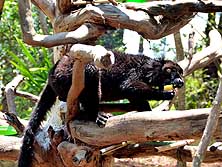
|
- 232
The Spiny-tailed iguana (Oplurus
- cuvieri) is common in Madagascar. Its
- special characteristic is the black collar
|
- 233
Is it not adorable, this little
- Lesser Bamboo Lemur
- (Hapalemur griseus griseus)?
|
- 234
Looks like the personified devil! This
- Black Lemur (Eulemur macaco) lives in
- Madagascar’s Northwestern rainforests
|
-
- At the end of our two-hour tour we come to the enclosure of the radiated tortoises. They
are just in a reproduction stage, bringing us back the troublesome memories of what we
read on September 7th, 2011, in the "L’Express" newspaper: According to the report the police
confiscated in villages in the South of Madagascar 8.2 tons (!) of smoked tortoises of
these endangered species!
|
-
-
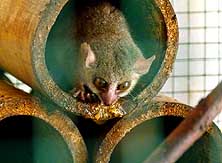
|
-
-
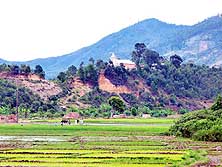
|
-
-
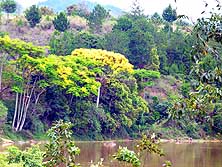
|
- 235
“No, I am not a mouse, I am a
- lemur!” The Grey Mouse Lemur
- (Microcebus murinus) is nocturnal.
- It weighs between 2.0 to 2.4 oz
|
- 236
An appealing sight: The village
- church West of Moramanga along
- the RN2 is perched between a
- mountain ridge and cultivated paddies
|
- 237
A blooming yellow Poui Tree
- dots the Mangoro river bank
|
-
- In the evening, we are back in Tana: “What next?” is now the question. Shall
we drive the 620 miles one-way to the most Northerly point or concentrate on the East.
Next day, on November 8th, a message in the newspaper makes our decision easier. It says
that in the North the rainy season has just started and that some areas are already
flooded.
|
-
-
-
-
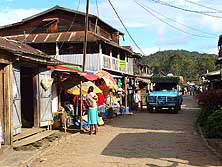
|
-
-
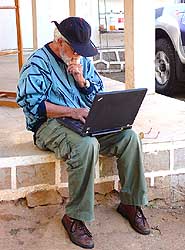
|
-
-
-
-
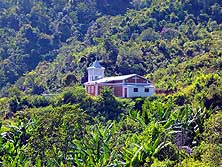
|
- 238
Our LandCruiser drives through
- the cobblestone main street of Andasibe,
- a peaceful little village in the Eastern high-
- lands, 16 miles East of Moramanga
|
- 239
Emil is trying hard to get
- an internet connection over
- the mobile net in Andasibe
|
- 240
Deep tropical greenery frame
- the lovely church East of Andasibe
|
-
- What a pity: Now we are just short of the three weeks we lost in the beginning when
haggling around with the dragging car release and my following pneumonia. Considering also
the problems we encounter with our shipping agent Auximad, which despite of numerous
emails and phone calls makes not any move to start with the preparations of our
forthcoming export shipment, our decision is quickly made: We have unfortunately to drop
the North and drive instead leisurely to the East, back towards the port of Tamatave.
|
-
-
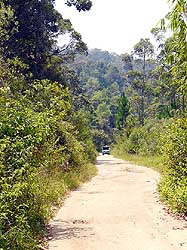
|
-
-
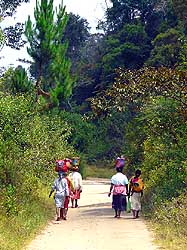
|
-
-
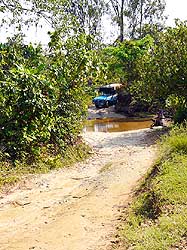
|
- 241
We are driving through dense
- vegetation to the Mantadia
- National Park near Andasibe
|
- 242
Women return from the market
- and walk back to their remote village,
- the goods placed on their heads
|
- 243
No reason for worries:
- The little river to cross is
- a breeze in the dry season
|
-
- Two days later we are woken up once more by the “melancholic” call of the
Indri in our bungalow at the hotel Feon’ny Ala in Antsirabe, where we make again a
stopover. The entire lemur family joins into the chorus. This is the way they communicate
with each other and with other groups and thus defend also their territory. It is
estimated that the Indri lives between 25 and 40 years. Seldom have we felt the closeness
to nature in such an extent like here, postponing therefore our departure day by day.
Because we know for sure: It’s a once in a lifetime experience, because these lovable
creatures live nowhere else on this planet – only on the island of Madagascar.
|
-
-
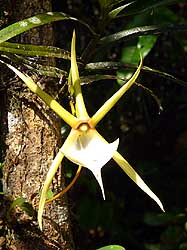
|
-
-
-
-
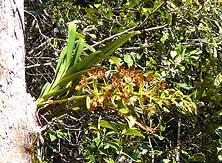
|
-
-
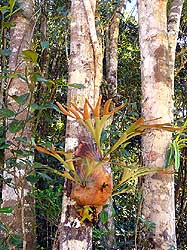
|
- At the orchid park in Andasibe we discover:
|
- 244
A white “Angrecum“ orchid
|
- 245
A “Grammangis elisii“
- (Grammatophyllum ellisii) orchid .....
|
- 246
and a beautiful stag horn fern
- (Platycerium bifurcatum)
|
-
- Sadness is taking over when finally after five happy days we are leaving behind the
kings of the lemurs. We need to return to the port of Tamatave to arrange our next
shipment – Auximad hasn’t done anything yet. After about 60 miles, right after
Brickaville, a track branches off to Manombato at Lake Rasobe with a sign “Chez
Luigi”. The name immediately rings a bell. “Did we not read somewhere that it is
a beautiful place?”
|
-
-
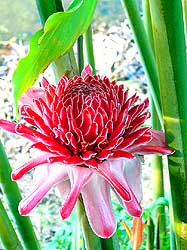
|
-
-
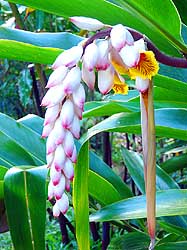
|
-
-
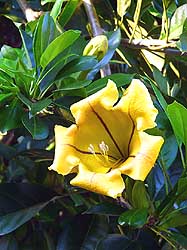
|
- In the flower garden of the hotel Feon’ny Ala in Andasibe we admire:
|
- 247
The Torch Ginger or
- Porcelain Rose (Etlingera elatior):
- A flower of great beauty
|
- 248
A Shell Ginger (Alpinia
- zerumbet) with its hanging blossoms
|
- 249
A Golden Chalice Vine
- (Solandra maxima) is flowering
- between the foliage of a tropical tree
|
-
- Spontaneously we branch away from the main road and follow the small track. It turns out
to be a really bumpy and stony drive through one deep pothole after the other. Luckily the
only river crossing is now during the dry season a piece of cake, because the rotten
wooden bridge is definitely not trustworthy. A few modest thatched huts, forests of
bottlebrushes and trees full of ripe red lychees line the path. Madagascar is the main
exporter of this tropical fruit to Europe, delivering around 20’000 tons a year.
|
-
-
-
-
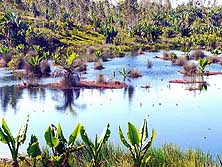
|
-
-
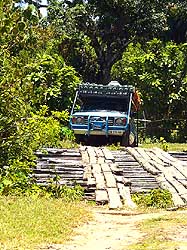
|
-
-
-
-
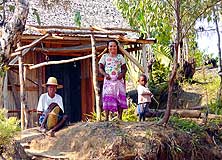
|
- 250
A pond dotted with tiny islets
- of plants is a lovely sight a bit South
- of Brickaville along RN2
|
- 251
How trustworthy is this wooden bridge
- on the adventurous track to Manombato
- on Lac Rasobe near Brickaville?
- (turnoff = PK286 along RN2)
|
- 252
The mother has a smile for us
- when we pass her modest home on
- the stony track leading to Manombato
|
-
- After 4 miles Lac Rasobe at Manombato is greeting us with an almost motionless surface
and a long white sandy beach, shining golden in the sun. However, after all we are not
ending up at “Chez Luigi” but at the Acacia Hotel 500 yards further on, where we
find a lovely beach bungalow. Being noon, we let ourselves pamper right away with a tender
Cebu Steak at the restaurant. How beautifully and peaceful life can be out here.
|
-
-
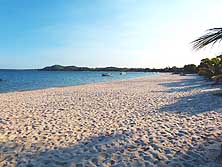
|
-
-
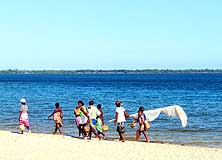
|
-
-
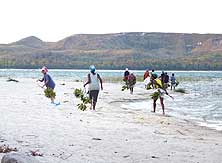
|
- 253
At Lac Rasobe, which is part
- of the Pangalanes Canal, we find a
- beautiful long white sandy beach
|
- 254
A group of people are walking
- along the beach of Lac Rasobe
- with their fishing net
|
- 255
The fishing group are returning with
- their catch from the sea still carrying their
- fronds with which they beat the water
- to chase small fishes into the net
|
-
- Fishermen are walking along with their fishing nets, canoes are bobbing up and down at
the shore, women are washing their evening dishes and scrubbing their soot-black pots with
sand before the sun sets. There is no electricity (our hotel offers electricity only from
6pm to 10pm with its own generator). When night falls we can detect only a very few lights
flickering in the distance, making the starry sky above us shining even more intensively.
|
-
-
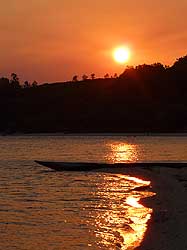
|
-
-
-
-
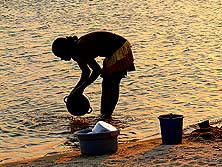
|
-
-
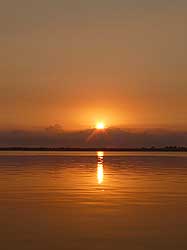
|
- 256
The sun is setting
- at Lac Rasobe
|
- 257
A girl washes her dishes and scrubs
- her sooted pots with sand before the sun
- sets at Lac Rasobe. There’s no electrical
- light at Manombato without
- an own generator
|
- 258
The sun is rising at Lac Rasobe,
- covering the almost motionless
- surface in a red glow
|
-
- At 5am dawn starts. There is no breeze. The lake looks as smooth as glass. Then the sun
is rising, flushing the surface of the water with a soft pink. It is such a lovely moment
that it intensifies our desire to stay a couple of days longer. There are two worries
preventing us to do so: Our concern that the big rains, which can start now any time,
would make the river crossing difficult if not impossible, and also the absolute inaction
of the shipping agent Auximad in preparing out export.
|
-
-
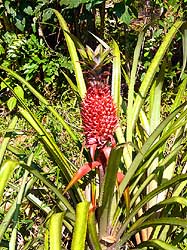
|
-
-
-
-
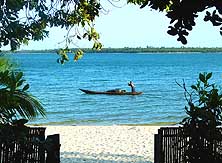
|
-
-
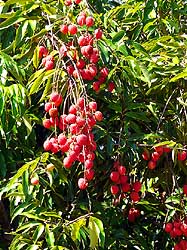
|
- 259
The pineapple belongs also to the
- tropical fruits growing in Madagascar
|
- 260
A life without hectic: A fisherman
- is poling his canoe along the
- Lac Rasobe shore
|
- 261
Ripe lychees hang from a tree.
- Madagascar is the main exporter
- of this tropical fruit to Europe,
- delivering around 20’000 tons a year
|
-
- Being cut off from the main road, would mean big troubles, particularly also regarding
our permissions. Our car’s permit and also our visas on the island run soon out after
three months and are non-extendable. Therefore we give us a kick and move on, hoping that
the emergency repair of the main leaf spring that broke yesterday on that rough track will
hold. Fortunately it does (it held during the whole stay on Réunion
and still in Miri/Sarawak/Malaysia, and due to
unobtainability it has to hold even longer). At noon we are already at the port city of
Tamatave and are sitting at our favorite seashore restaurant: The “Ocean 501”.
|
-
-
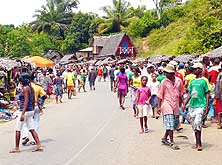
|
-
-
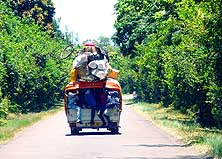
|
-
-
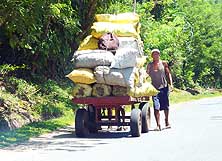
|
- 262
Crossing a village on a market
- day is always an exciting experience.
- Here the one of Ampasimadinika
- South of Tamatave (Toamasina)
|
- 263
No matter where and how
- comfortable one sits – the main
- thing is to get a ride. Taxi Brousse
- are always overpacked
|
- 264
A little break: Pushing a heavily
- loaded cart by hand is hard work –
- for many though the only mean
- to transport their goods
|
-
- The pork sausage we are eating with such a pleasure, does not do us any good at all.
Emil is the one who suffers the most. In Mexico one would name it: “Montezuma’s
revenge”. Next day, he is sitting on the toilet with diarrhea more than 20 times
within 12 hours. The second day it is not much better. The hotel Flamboyant where we
actually wanted to spend only one night sends a boy to the pharmacy to get
“Ercéfuryl” tablets that slowly improve the situation.
|
-
-
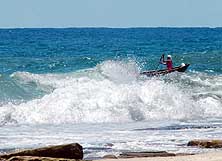
|
-
-
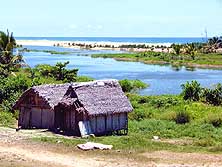
|
-
-
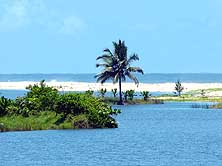
|
- 265
A fisherman does not know
- any fear. Even the breaking of a high
- ocean wave does not stir up his blood
|
- 266
Between Tamatave (Toamasina)
- and Foulpointe (Mahavelona) at the
- East coast, we pass a coastal stretch
- with attractive views, be it with
- traditional thatched huts …..
|
- 267
….. or with an azure blue
- lagoon and a white sandy beach
|
-
- Then, it is my turn and during the third night the bathroom is continuously occupied by
one of us. On the forth day, we are both up again. After having also dismissed the broker
Auximad and initiated the shipping preparations for La Réunion
in December with the more reliable “SDV Madagascar”, nothing can hold us anymore
in this hot and humid port city. We move along the East coast towards the North.
|
-
-
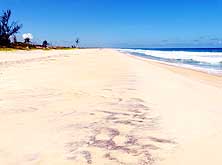
|
-
-
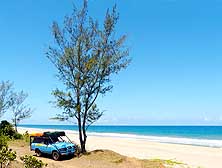
|
-
-
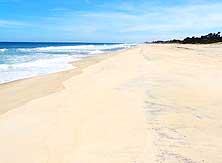
|
- 268
An endless lonesome sandy beach
- attracts us at the East coast between
- Tamatave (Toamasina) and Foulpointe
- (Mahavelona). Here we look
- towards the North from …..
|
- 269
….. our lovely picnic
- spot near Vohitsara …..
|
- 270
….. and here we look
- towards the South
|
-
- Our target is the highly praised “La Pirogue” Lodge in Mahango. There, we want
to pamper ourselves with a few days “vacation” at the seashore. And once more it
turns out to be pretty different from what we thought and expected. If prices for a
bungalow with bunk beds in backpacker-style cost Aria 136’000 US$ 63) and for a more
comfortable accommodation more than Aria 200’000 (US$ 93) – electricity provided
for a few hours daily only – we are at the wrong place. We find “our” place
a bit more to the South at Foulpointe at the Manda Beach Hotel: A lovely spacious bungalow
directly at the beach with veranda, fridge and satellite TV, unfortunately no wi-fi.
Therefore, we are for once prepared to dig deeper into our pocket as normal, paying Aria
99’000 (US$ 46) a night, enjoying ourselves for three days.
|
-
-
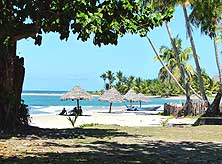
|
-
-
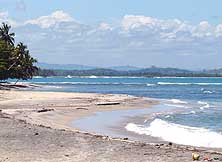
|
-
-
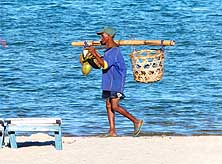
|
- 271
The beach at “La Pirogue” Lodge
- in Mahambo at the East coast brings
- back old memories of the Caribbean
|
- 272
White sandy beaches line the
- remote East coast at Mahambo
|
- 273
A coconut vendor walks along
- the beach seeking thirsty customers
|
-
- December 6th, – our last holiday’s day at the beach. It dawns. We are sitting
on the porch gazing out to the sea, to the dark clouds forming on the horizon and wait for
the always beautiful moment of the sunrise. When its yellow ball appears the rays
transform the lagoon into a silvery glow. We watch canoes punting through the almost
motionless surface and white crest waves shooting high up along the reef – a magic
moment. When we pack our belongings into the car to drive the 30miles back to the shipping
port of Tamatave, the beach gets slowly alive with joggers, souvenir vendors and
sunbathers. The deckchairs below colorful umbrellas start to fill up.
|
-
-
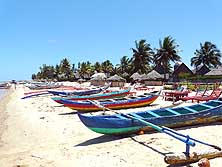
|
-
-
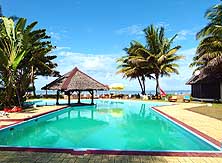
|
-
-
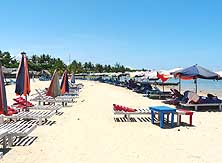
|
- 274
Brightly painted traditional fishing
- boats line the Northern part of the
- white sandy beach at the
- Manda Beach Hotel in Foulpointe .....
|
- 275
..... in the middle is the
- lovely hotel swimming pool .....
|
- 276
..... and on the Southern part
- are the deck chairs where
- tourists are sun tanning
|
-
- One day later, on December 7th, 2011, we have to say good-bye once more to our trusty
LandCruiser. Driving it into the container and lashing it has long become a routine to
Emil. This is the 24th time! However, our “buddy” will still have to wait in the
sweltering heat at the container yard of our agent “SVD Madagascar” until
December 14th. The ferry “Trochetia” from Mauritius
runs only once a month from Madagascar to the neighboring island of La Réunion. Unfortunately our three monthly visa already ends
on December 11th, – three days too early to be able to join the ship as passengers.
|
-
-
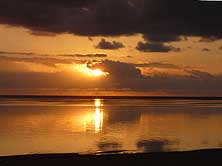
|
-
-
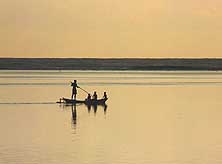
|
-
-
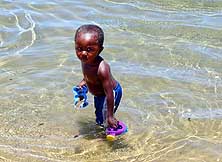
|
- 277
The morning glow announces
- a new day in Foulpointe
|
- 278
Foulepointe: Early morning, a
- father glides with his canoe and three
- children over the almost motionless
- waters of the lagoon
|
- 279
A little boy plays with his
- toys at the Foulpointe beach
|
-
- There are still three days to go before our departure with Air Austral to Réunion
– three days with headaches, because the scanning of our container in the port cannot
be done prior to our departure due to capacity overload, what means: We will have to hand
over the car keys. Also the big boss of the SDV agency insists. He explains in plain
language that there must be the possibility to open the car in case something suspicious
appears on the scanner. “What happens if we refuse”, we ask upset. “It is
as simple as this: Your container will not be transported” is his clear and ultimate
answer. Well, what choice do we have? After the boss guaranties that his people will
supervise the procedure and that we can trust them, we finally back down. We fiddle a bit
in surrendering only the key to the tailgate and lock the driver’s door with an
additional padlock.
|
-
-
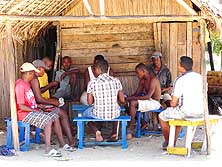
|
-
-
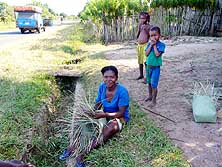
|
-
-
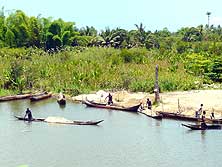
|
- 280
Playing cards is a popular pastime,
- also at a beach shack in Foulpointe
|
- 281
A mother is weaving with
- Raffia palm fibers a basket while
- her two children watch her
|
- 282
At the Ivoloina River, 7½ miles
- North of Tamatave men dive with
- baskets for sand on the riverbed
- that is used as constructing material
|
-
- On our last day we let ourselves drive with the elderly “pousse-pousse” driver
– the cycle rickshaw – through the streets of this harbor city. We draw in the
last time the scent of the aromatic cloves that are spread out on clothes at the sideways
to dry, watch for the last time the familiar colorful hustle and bustle, the women with
their babies strapped to the back, the coconut venders with their highly loaded wooden
cart, the improvised food corners – the unmistakably African way of life. Even the
dusty potholed streets, at the moment adorned with the red flowering Flamboyant trees, we
do consider not that bad anymore.
|
-
-
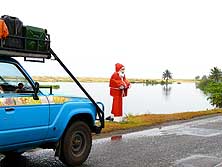
|
-
-
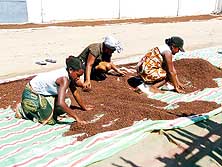
|
-
-
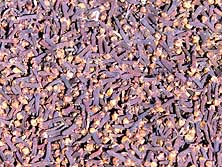
|
- 283
Is it not a lovely providence that
- we drive past Santa Claus exactly on
- December 6th, on our way back from
- Foulpointe to Tamatave?
|
- 284
At a side street in Tamatave
- three women are spreading out piles
- of cloves on a cloth to dry in the sun
|
- 285
We smell the spicy scent of
- cloves already from far away
|
-
- When we carry our luggage to the waiting taxi, the “pousse-pousse” drivers who
always line up in front of the Flamboyant Hotel to wait for guests, wave us good-bye with
a hearty smile. It is December 10th, 2011, 1pm. Sadness takes over on our way to the
airport. Madagascar – the special island in the Indian
Ocean – will be history in a few hours. Who knows how it will look if we ought to
show up – even without car – one more time in the future.
|
-
-
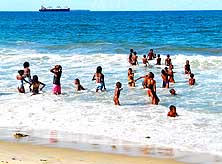
|
-
-
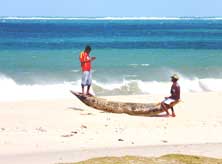
|
-
-
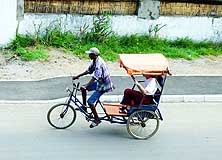
|
- 286
At the beach in Tamatave we
- see mostly children bathing and
- playing in the polluted water
|
- 287
Two fishermen pause with their
- canoe at the beach in Tamatave
|
- 288
Liliana takes a bicycle rickshaw
- (Pousse-pousse) to the supermarket
- in Tamatave while Emil lies
- down with a diarrhea
|
-
- We covered a distance of 2’700 miles in 148 driving hours and got to know a
population that – despite of its great poverty – shows a joy for life. The cute
lemurs, the picture book villages in the highlands, the baobabs in the West, the colorful
markets bursting at the seams and the artful rice terraces were each day a pleasant sight
during our journey criss-crossing the country.
|
-
-
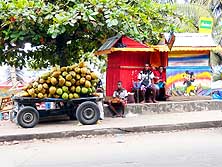
|
-
-
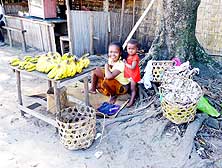
|
-
-
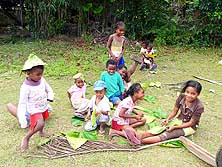
|
- 289
At Tamatave’s beach front piles
- of young coconuts are on offer.
- Passersby love to quench their thirst
- with the vitamin-rich juice inside
|
- 290
At a street corner, a girl looks
- after the banana stall together
- with her little sister
|
- 291
In a neighborhood of Tamatave
- school children are busy making hats
- from leaves of the “Travelers Tree”
- (Ravenala madagascariensis)
|
-
- What we had preferred not to see are the many forest fires. 80% of the Madagascan
forest is already irrevocably lost. The natural habitat of
the lemurs gets smaller day by day. And what we had preferred not to read are the two
depressing messages in recent newspapers: 233 Indri killed for bush meat, the biggest of the still living
lemurs, and that 8.5 tons of smoked radiated turtles – both endangered species – were seized in villages in the South of the
island. If this does not get under control very soon, Madagascar will be in no time not
anymore the special island in the Indian Ocean where we had the privilege to tour and
which will continue to live in our memories.
|
-
-
-
-
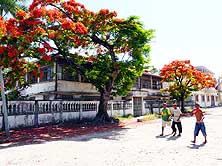
|
-
-
-
-
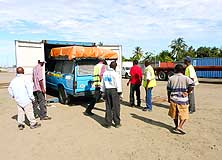
|
-
-
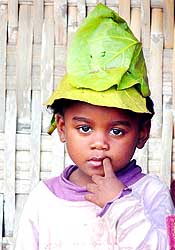
|
- 292
The Flamboyant Trees (Delonix regia)
- in Tamatave are in full bloom when we
- make the preparations for the shipment
- of our LandCruiser after our three
- months’ stay in Madagascar
|
- 293
Saying once more good-bye
- to our faithful LandCruiser. Emil is
- driving it in Tamatave into its
- 24th container with
- destination: La Réunion
|
- 294
One of Liliana’s most treasured
- pictures: What is this adorable little
- girl from Tamatave with her
- selfmade hat from the leaves of a
- “Traveler’s Tree” thinking?
|
-
|
| More
websites from Madagascar:
|
|
![]()
